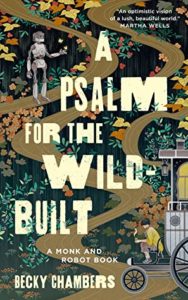
Title: Neuro Noir
Author: Al Hess
Publisher: Self-Published
Publication Date: January 1, 2022
Genres: Science Fiction, Mystery, Romance, LGBTQ+
Length: 42 pages
Source: I received a free copy from the author.
Rating: 5 Stars
Blurb:
Prominent council member. Omniscient custodian of City Entry. Mystery book aficionado. As the oldest A.I. Steward existing within the network of Salt Lake City, Lysander has seen most everything.
When a death in the overcrowded and chaotic subway leaves fellow Steward Beatrice distraught and imploring Lysander to find a way to lessen the odds of it happening again, he’s happy to do what he does best: advise, console, and achieve solutions. But doing so means working with the human council member he absolutely, most assuredly does not have feelings for – no matter how perceptive and charming said council member is. And something about the issue in the subway is giving Lysander the itchy sort of dread he gets when reading his mysteries.
But Lysander’s life isn’t an impartial story plucked from his “to read” pile. As he closes in on the source of Beatrice’s problems, he realizes the situation is far more personal than he’s prepared for. If he isn’t careful, even the wisest and most experienced of Salt Lake’s Stewards will miss the clues, putting himself – and those he cares for – in danger.
This is a 10k word prequel novelette to the queer and cozy wasteland road trip romance, World Running Down.
Review:
Content Warning: mild profanity, threats of violence, and death
Customer service is the most important part of the job…even if you’re not exactly human.
To be perfectly honest, it took me a little while to figure Lysander out because of how different some of his thought processes were from the humans he protected on public transit and at certain entrances and exits every day. This was an excellent thing, though, because of course artificial intelligence wouldn’t react to certain stimuli like we would! Once I figured out why he was more bothered by stuff that many humans would ignore, his thoughts about his role as a Steward became much clearer to me. The process of sorting out his ideas was a rewarding one, and it endeared me to him. On a more personal note, I also enjoyed his reactions to the customer service elements of his position, especially when dealing with people who were not always necessarily kind or rational when dealing with him.
The romance was handled beautifully, and that’s something I’m saying as someone who doesn’t spend much time in that genre. I loved the way this storyline was slowly allowed to build up before it began playing a larger role in the plot. It suited the characters involved in it nicely and gave me plenty of time to understand why they were interested in each other and why they might make a good match.
I was also thrilled with the world building. Obviously, a short story isn’t going to have as much time for this as a full-length novel would, but the author did an excellent job making use of all forty-two pages to show what a city protected, maintained, and even run to a certain extent by artificial intelligence might look like behind the scenes. It made me curious to see what World Running Down might be like, so the author did a great job of giving this reader a taste of his world here.
Neuro Noir was a wild ride that made me wish it wouldn’t end.

 Title:
Title:  Title: The Cybernetic Tea Shop
Title: The Cybernetic Tea Shop Title: A Prayer for the Crown-Shy
Title: A Prayer for the Crown-Shy Title: A Psalm for the Wild-Built (Monk & Robot #1)
Title: A Psalm for the Wild-Built (Monk & Robot #1) Title: Restore – Stories of Singularity #1
Title: Restore – Stories of Singularity #1 Cadwell Turnbull’s “
Cadwell Turnbull’s “ John Scalzi’s “
John Scalzi’s “ Vintage Science Fiction
Vintage Science Fiction The first thing that grabbed my imagination when I was reading this tale had to do with the destruction of the natural environment. There was so much devastation everywhere the characters looked.
The first thing that grabbed my imagination when I was reading this tale had to do with the destruction of the natural environment. There was so much devastation everywhere the characters looked.